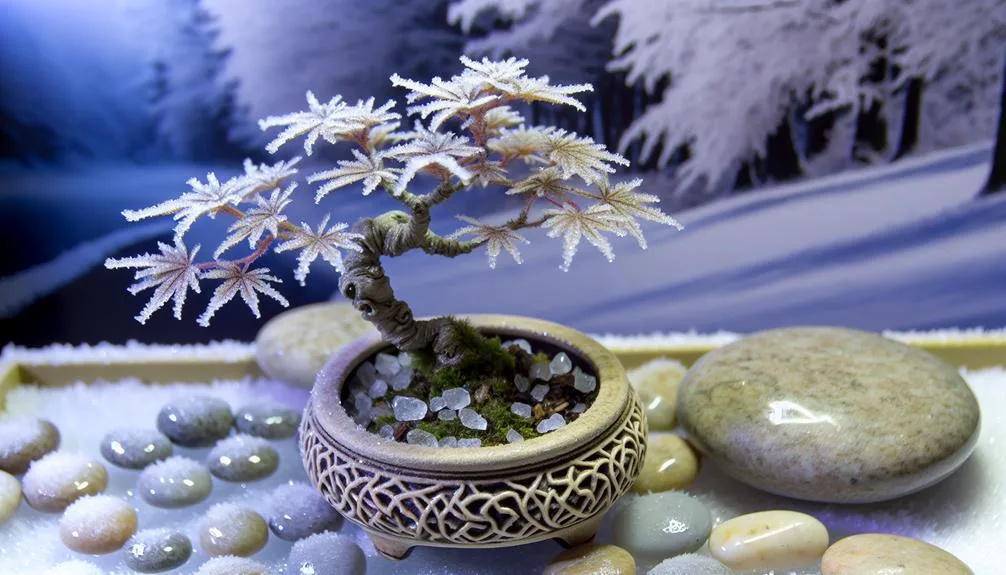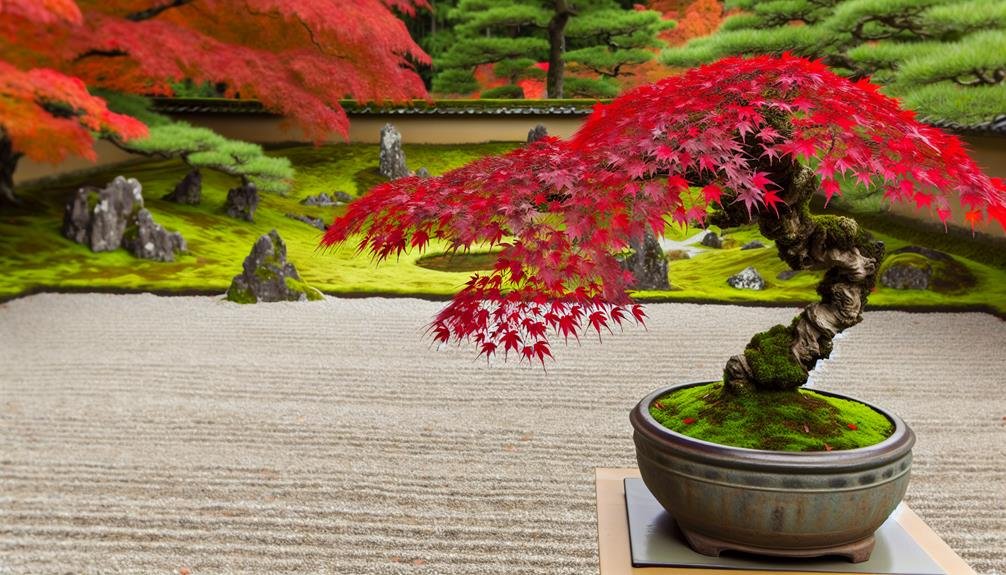Japanese Maple Bonsai care requires not just patience and dedication, but also a comprehensive understanding of this specific species.
My experience is steeped in the varied aspects of care required for these delicate Japanese maple trees. I’ve grappled with decisions regarding the perfect placement for optimal sunlight, learned the nuances of watering and fertilizing, and honed my skills in the art of pruning and repotting.
In Japanese culture, the Japanese Maple holds significant symbolism and is associated with grace, beauty, and tranquility. It is often featured in Japanese gardens as a focal point or used in bonsai cultivation.
One of the most captivating characteristics of Japanese Maples is their seasonal color transformations. In spring, the foliage begin as green, shifting to brilliant shades of red, yellow, and orange during autumn. When winter arrives, the leaves fall, unveiling the tree’s complex branch structure.
As I reveal my journey through these topics on this bonsai forum, you’ll begin to grasp the complexities and peculiarities of maintaining a flourishing and healthy Japanese Maple Bonsai.
This endeavor has ignited a deeper interest and involvement in the fascinating area of Japanese Maple Bonsai care for me, and I believe it will do the same for you.
Choosing the Perfect Japanese Maple
To choose the perfect Japanese maple bonsai tree, consider the following factors:
- Variety: Some popular varieties include Acer palmatum, Acer buergerianum, and Acer palmatum ‘Bloodgood’. The Kiyohime maple is recommended for its unique growth habits, color patterns, and smaller size, making it an ideal choice for creating a beautiful miniature tree.
- Bonsai Suitability: Japanese maples are ideal for bonsai due to their slow growth habit and non-invasive root system. Consider the picture you want to create with your bonsai and select a variety that aligns with your desired outcome.
- Care Requirements: Japanese maple bonsai thrive in sunny and airy locations, but should be protected from direct sunlight when temperatures rise. They should be watered daily during the growing season and repotted every two years.
- Pot Selection: Choose a handmade bonsai pot that is frost-resistant and complements the colorful leaves of the Japanese maple.
Sunlight requirements of the Japanese Maple Bonsai during early spring.
Selecting the ideal Japanese Maple Bonsai first involves understanding the tree’s preference for sunlight. The Japanese Maple Bonsai, similar to other Japanese maple trees, flourishes in bright and breezy spaces. However, protection from indirect sunlight is necessary when temperatures go above 85°F (30°C) to prevent leaf damage.
Determining the watering parameters for ensuring healthy foliage in the Japanese Maple Bonsai.
Watering the Japanese Maple Bonsai is a delicate process. The tree prefers water with a neutral or slightly acidic pH-value. Rather than sticking to a strict watering schedule, observing the bonsai soil to stop it from completely drying out is crucial.
Fertilizing Needs of the Japanese Maple Bonsai
The Japanese Maple Bonsai flourishes with solid, organic fertilizers. Avoiding high nitrogen concentration is recommended as it can lead to excessive leaf and internode growth.
Trimming Requirements for the Japanese Maple Bonsai
Trimming of shoots and twigs can be done throughout the year for the Japanese Maple Bonsai. Using a cut paste product when pruning thick branches is advised to combat fungal diseases.
Repotting Schedule for the Dwarf Japanese Maple
Repotting the Dwarf Japanese Maple should happen every two years with the use of a well-drained soil mixture. Adherence to these guidelines will be instrumental in selecting the perfect Japanese maple.
Essential Care for Maple Bonsai
Essential care for Maple bonsai encompasses strategic positioning, routine hydration, suitable fertilization, meticulous pruning, and timely repotting.
Having chosen your ideal Japanese Maple (Acer palmatum) bonsai, gaining knowledge about the vital care practices is pivotal for the tree’s optimal growth and long life.
| Bonsai Maintenance Aspect | Techniques | Tools Required |
|---|---|---|
| Positioning of Bonsai | In well-lit, ventilated spots with dappled sunlight in high temperatures | – |
| Hydration Practices | Daily in the growth season, never let the soil turn dry | Bonsai-specific pots |
| Fertilization Strategy | Solid, organic for adult trees, liquid for saplings | Bonsai-specific fertilizer |
| Pruning Regime | All year round, intensive pruning in spring and summer | Specialized bonsai tools |
| Repotting Schedule | Biennially with well-draining soil | Bonsai-specific pots |
Saplings might need altered watering and fertilizing strategies. Intensive pruning should be performed in spring and summer to avoid excessive sap loss. Bonsai-specific tools and pots are necessary for these activities. Adherence to these guidelines will help your Japanese Maple bonsai trees thrive and prolong their lifespan.
Pruning Techniques and Tips
Japanese Maple Bonsai Pruning Techniques for Health and Aesthetics
To maintain the health and aesthetic appeal of your Japanese Maple Bonsai, it is critical to master effective pruning techniques and understand the associated tips. Pruning, a fundamental aspect of bonsai design and maintenance, aids in controlling growth and defining the tree’s form.
Year-Round Trimming of Shoots and Twigs
Throughout the year, regular trimming of shoots and twigs is essential to keep your Bonsai’s size and shape in check. Special attention should be given to new shoots, especially young ones in spring. This promotes a stronger tree structure. Pruning new growth back to one or two pairs of leaves encourages a compact and aesthetically appealing shape.
Pruning Strong Branches in Summer or Autumn
Strong branches should be pruned in the summer or autumn to prevent excessive bleeding. When pruning thick branches, using a cut paste product is recommended to stave off potential fungal diseases.
Partial Defoliation Technique for Enhanced Aesthetics
A unique technique, partial defoliation, involves removing some leaves from the tree. This technique encourages finer branching and ramification, thus enhancing the tree’s delicate aesthetic.
Winter Pruning and Cold Protection
While maintaining the bonsai’s shape with continued pruning in winter, remember to protect your tree from severe cold to prevent damage.
Final Thoughts on Japanese Maple Bonsai Pruning Techniques
With these pruning techniques and tips, your Japanese Maple Bonsai will flourish, maintaining a healthy and well-formed appearance throughout the year.
Propagation of Japanese Maple Bonsai
Propagation of Japanese Maple Bonsai can be achieved through seeds, cuttings, or air-layering. The latter two methods utilize the raw material from an existing tree, best suited for this process, with softwood cuttings taken in early to midsummer being particularly effective.
However, it’s important to note that bonsai are susceptible to stress during this process. Therefore, young trees should not have more than half of the root mass removed during repotting. To increase the success rate of cuttings, consider using bottom heat.
These delicate trees, native to Japan, are most vibrant when they sprout new leaves in the spring, exhibiting a spectrum of green leaves turning into captivating red leaves in the fall. To help your bonsai thrive, provide it with liquid fertilizer and ensure it resides in partial shade.
The practice of propagation not only creates additional trees for your collection but also contributes to the preservation of this traditional art form.
Overwintering Your Bonsai Tree

Overwintering Your Japanese Maple Bonsai Tree
Navigating the winter months with your bonsai tree requires special attention to protect it from freezing temperatures, heavy winds, and to ensure its survival during dormancy. Proper care is crucial during this period, especially for the tender bark of young trees.
Here are the key steps for overwintering your Japanese Maple Bonsai:
- Root Insulation: Protect the roots of your bonsai from freezing temperatures by burying the pot in garden soil or wrapping it in insulating materials like bubble wrap or burlap.
- Frost-free Environment Provision: After the fall of the leaves, relocate your Japanese Maple Bonsai to a location shielded from heavy winds that is also frost-free.
- Winter Watering: Only water your bonsai when the soil is dry. Make sure that your tree does not dry out completely during the winter dormancy period.
- Maintenance of Your Japanese Maple Bonsai: Your Japanese Maple Bonsai should be repotted every two to three years to prevent issues such as root rot and Verticillium wilt. Avoid applying wire in winter as it can damage the young tender bark.
Follow these steps from the Japanese Maple Bonsai Guide to ensure your tree continues to thrive through the winter.
Handling Pests and Diseases
Handling pests and diseases that might jeopardize the tree’s health and vitality while ensuring your Japanese Maple Bonsai survives the cold winter months is crucial. It is equally important to vigilantly monitor and use careful observation and prompt response. Routinely inspect the bonsai for aphids, caterpillars, beetles, and other threats. Utilize insect repellents or manually remove pests, and ensure your tools are clean to prevent the spread of diseases.
Equally important is the prevention of fungal infections, often caused by overwatering or poor ventilation. These can be particularly harmful to your bonsai, especially varieties with a shallow root system. To foster new growth, avoid overwatering and ensure proper ventilation.
Your care regimen should include organic bonsai fertilizer to bolster the tree’s resilience against pests and diseases. Regularly propagating your bonsai, either through seeds or cuttings, can also ensure its vitality. Remember, for successful propagation, a well-draining, slightly acidic soil and shaded environment are key.
Care, vigilance, and appropriate handling of pests and diseases will ensure your bonsai’s long-term health and beauty.
Frequently Asked Questions
How Do You Take Care of a Japanese Maple Bonsai Tree?
To care for a Japanese Maple Bonsai, ensure it’s placed in a sunny, airy location but protected from extreme temperatures. Water daily, use organic fertilizers, prune regularly, and repot every two years with well-drained soil.
What Is the Best Bonsai Style for Japanese Maple?
The optimal bonsai style for a Japanese Maple is typically the ‘informal upright’, reflecting its natural growth pattern. Other styles like ‘raft’, ‘root over rock’, ‘multiple trunk’, and ‘cascade’ may also be explored.
How Much Sun Does a Japanese Maple Bonsai Need?
A Japanese Maple Bonsai needs a sunny, airy location. However, when temperatures exceed 85°F, it should be placed in indirect sunlight to prevent leaf damage. During cold spells below 15°F, additional protection is necessary.
How Long Does It Take to Grow a Japanese Maple Bonsai?
Growing a Japanese Maple Bonsai to maturity typically takes 5-10 years. This duration can vary based on factors like tree age, care techniques, specific variety, and environmental conditions like sunlight, water, and soil quality.




